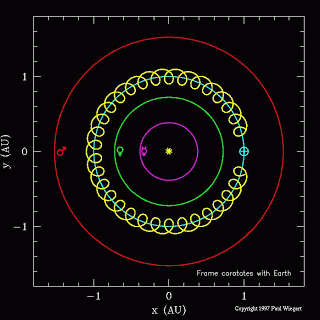Mini moons
Interlopers. Hangers-on. Hitch-hikers. Parasites. Guardian angels. Extended family. Entangled relationships from which you will never escape.
Take your pick.
The earth has more than one moon.
Okay, technically they aren't moons, since they don't rotate the earth, but are instead "co-orbital objects," that gravitationally interact with us as we make our way around the sun. They don't shine, they're too small to reflect back much sunlight, they are dark chunks of rock, leftover from the birth of the solar system.
And there are several of them, but I wanna talk about the largest one today.
3753 Cruithne (pronounced "krooy-nyuh," named for a King of the Celtic Picts) is the coolest of all, because of its very strange horseshoe shaped orbit. Of course, all orbits are ellipses, but from the point of view of the earth, Cruithne's orbit is a set of spirals that, taken together, form a horseshoe (the picture below is a simplified version). I'd be lying to say I understand it fully, and I've been pondering it for weeks now, but the result is a stable and carefully choreographed two-body orbit where neither object will hit the other one.

Please don't this this as a sign of intelligent design, or some uber-mind in charge of a great celestial clockworks. It's not. The reason Cruithne is in such a stable (albeit intricately choreographed) orbit is simply because if it were in an unstable orbit, it would have been flung into space, the sun, or even the earth. Like that thing that killed the dinosaurs. It's the cosmic version of "last man standing," and if it is evidence of anything, it is evidence of endless possibility, of the bounty of patterns nature can form from such simple building blocks.



